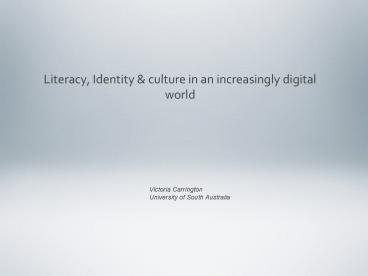Literacy, Identity PowerPoint PPT Presentation
1 / 25
Title: Literacy, Identity
1
Literacy, Identity culture in an increasingly
digital world
Victoria Carrington University of South Australia
2
My starting position
- New Literacy Studies
- literate practices are socially situated
- literate practices, texts and technology are
closely linked - shifts in these are closely linked to broader
social/cultural/political changes
3
Crises are interesting
4
(No Transcript)
5
participatory culture
Jenkins et al 2006
6
Digital futures The Internet in Australia
- 8 out of 10 Australians have used the Internet
72.3 are current users - 95.1 of 18-24 year olds use internet
- 25.3 of internet users use mobile devices (under
an hour a week) - 8 out of 10 (and growing) home internet
connections are broadband - (ARC Centre of Excellence for Creative Industries
and Innovation (CCI)
- Kaiser Foundation/Pew Internet/MacArthur
Foundation - 83of kids play video games
- 53 have created media content
- millions of kids are active on social networking
sites - by 2011, 50 of kids will be visiting virtual
worlds
7
(No Transcript)
8
web 1.0
9
web 2.0 blogs
researching/evaluating/compiling/ disseminating
audience
120,000 new blogs/day 1.5 million posts/day 17
posts/second 37 Japanese 33 English 8
Chinese Italian 3 (Technorati 2007)
navigation
Chinese internet 72.8 million blogs 29 million
active 47 million bloggers (CNNIC 2007)
10
Blogging
507,000 English language posts/day
11
bebo.com
12
7th July 2005 - London bombing
- BBC News received
- 20,000 emails
- 3,000 images
- 1,000 email videos and stills
- 3,000 text messages
Targeted Londons public transport system. 3
bombs in the Tube network, 1 bomb on bus. 52
commuters 4 suicide bombers killed, more than
700 injured
13
Trappedunderground.jpg One of Time Magazines
Best Photos of 2005
14
2.0 textual practices
- multimodal, dynamic, mix/mash
- construction, rehearsal of social identities via
production of texts - uses of text to participate - creating,
interacting, mentoring, learning, networking,
collaborating, collective intelligence - New spaces to socialize
15
Virtual worlds - Web 3.0
16
(No Transcript)
17
How popular?
- Tipping point already reached 6.2 million kids
aged 6-12 have been in a virtual world in last 12
months 50 new virtual worlds are due for
release by 2009 by 2011 more than half of all
kids will be visiting virtual worlds regularly
- 10 and under Neopets (45m), BarbieGirls
(12m), Webkinz (5m), Club Penguin (17m) - 20 and under WeeWorld (21m), Habbo
(90m), Gaia (12m), Club Penguin (17m), Whyville
(3m)
18
whyville (3 million)
Launched 1999, developed by CalTec 10-16 year
olds Specifically educational Linked to sponsors
- NASA, Scholastic, Toyota, Disney Avatar - head
only
19
(No Transcript)
20
Gaia (12 million)
- Anime-influenced
- High customization - avatar and home
- Social gaming
- Forum focused - guilds
21
Following target market online Virtual world as
a toy 25 of site is open access - remainder
requires purchase Usage (April 2008) under 6 -
2 7-8 - 12 9-10 - 35 11-12 - 30 13-15 -
18 30,000 new registrations/day
BarbieGirls (13 million)
22
Virtual worlds
- Diverse educational, mirror, branded, role
playing - Opportunities for new social spaces,
interactions, customization, practices with a
variety of texts, informal learning - Culturally significant social spaces and
activities for young people - Value laden gender, consumption, economic model,
family life, race, cultural practices, role/uses
of technologies
23
Why is this relevant?
- Embedding of digital technologies
- Unstoppable diversification
- Emergence of cultural momentum towards
participation - Information and expertise
- Powerful practices with text and technology
- Ongoing pressure around access and skill
24
Literacy skills for participation in a diverse,
digital world?
Reading skills/strategies word recognition,
comprehension, scanning text in order to retrieve
information, familiarity with different text
organization/structure authors viewpoint,
purpose and overall effect of the text on the
reader Writing skills/strategies spelling,
punctuation, syntax, adapting range of forms,
using language for effect, writing for
known/unknown audiences, using text to negotiate
and collaborate read Jackie Marsh at
http//digitalbeginnings.blogspot.com/
25
victoria.carrington_at_unisa.edu.au

